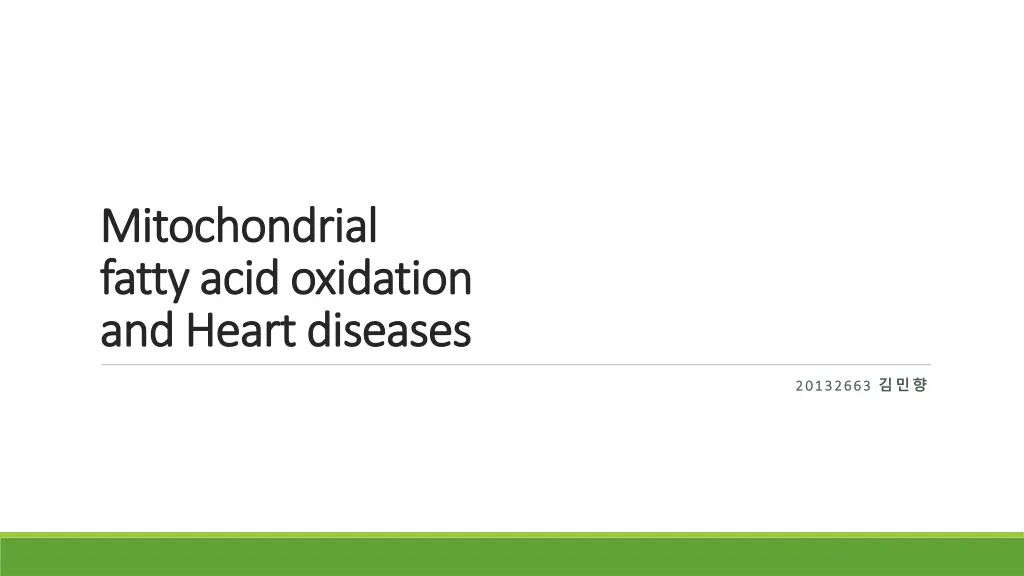
Fatty Acid Oxidation and Heart Diseases Insight
Explore the intricate relationship between mitochondrial fatty acid oxidation and heart disease, including mechanisms, regulation, and implications for conditions like heart failure and diabetic cardiomyopathy. Learn about key enzymes, metabolic pathways, and the impact of fatty acid metabolism on cardiac efficiency.
Uploaded on | 1 Views
Download Presentation

Please find below an Image/Link to download the presentation.
The content on the website is provided AS IS for your information and personal use only. It may not be sold, licensed, or shared on other websites without obtaining consent from the author. If you encounter any issues during the download, it is possible that the publisher has removed the file from their server.
You are allowed to download the files provided on this website for personal or commercial use, subject to the condition that they are used lawfully. All files are the property of their respective owners.
The content on the website is provided AS IS for your information and personal use only. It may not be sold, licensed, or shared on other websites without obtaining consent from the author.
E N D
Presentation Transcript
Mitochondrial Mitochondrial fatty fattyacid acidoxidation and andHeart diseases Heart diseases oxidation 20132663 20132663
Fatty acid oxidation Fatty acid transporter CD36/FAT Fatty acid binding protein(FABP) CPT-1/CPT-2 cycle Acyl-CoA dehydrogenase Enoyl-CoA hydratase 3-hydroxyacyl-CoA -Ketoacyl-CoA thiolase
Regulation of fatty acid oxidation Randle cycle a biochemical mechanism involving the competition between glucose and fatty acids for their oxidation and uptake in muscle and adipose tissue. Fatty acid oxidation decreases glucose metabolism . (From fatty acid oxidation) NADH Acetyl CoA Inhibit PDH increased Citrate level Inhibit PFK1, hexokinase Cytosolic events controlling fatty acid oxidation Increased glucose oxidation can inhibit fatty acid oxidation. Malonyl-CoA concentration Inhibit (From PDH) Acetyl CoA 3-ketoacyl CoA thiolase Integration of AMPK and ACC in the glucose-fatty acid cycle Fatty Acid Uptake Inhibit (From glucose oxidation) NADH 3-hydroxyacyl CoA dehydrogenase
Regulation of fatty acid oxidation Fatty acid are a less efficient energy substrate than glycose. One glycose molecule Consumes 6 O2 Produces 31 ATP One palmitate Consumes 23 O2, Produces 31 ATP Since this mechanism only accounts for 10% of the reduction in cardiac efficiency But elevated fatty acid oxidation can result in up to a 30% decrease in cardiac efficiency Other mechanisms are also involved in the reduction in cardiac efficiency observed in hearts with elevated rates of fatty acid oxidation : uncoupling proteins and increased triacylglycerol(TG) cycling
Regulation of fatty acid oxidation ACC Acetyl CoA Malonyl CoA MCD Malonyl CoA Long chain Fatty acyl CoA Fatty acyl -carnitine CPT-1 MCD inhibition has been shown to decrease cardiac fatty acid oxidation and improve cardiac function.
Fatty acid oxidation in Heart disease A. Heart Failure B. Ischemic/Reperfusion C. Diabetic Cardiomyopathy
Heart failure Mitochondrial metabolism is reduced 30-40% decrease in ATP levels and large decrease in phosphocreatine levels in the heart. In hypertrophied heart due to pressure overload, this change in overall metabolic rate is accompanied by change in expression and activity of transcriptional protein. : inducible factor-1 , PPAR , PGC-1 : uncoupling of glycolysis , production of protons : this can alter ionic homeostasis It is also associated with a decrease in glucose and lactate oxidation rates. : Damages mitochondria in cardiomyocyte : Affects mitochondrial oxidative phosphorylation, fatty acid oxidation : Increasing PDK4 expression, decreased PDH activity : Reduce APT levels Angiotensin
Ischaemia / reperfusion : mitochondrial oxidative metabolism decreases in proportion to the decease in oxygen supply to the heart ischaemia : cardiac fatty acid oxidation rates are elevated due to elevated circulating reperfusion of the ischaemic heart : inhibition of glucose oxidation rates with decrease in glucose oxidation rates Elevated levels of circulating fatty acid combined with a decrease in malonyl CoA levels : increased uncoupling of glycolysis from glucose oxidation and increase in production of lactate and protons which can decrease cardiac efficiency and impair heart function. The decrease in glucose oxidation : accumulation of intracellular calcium and sodium The mechanisms involved in removing protons
Diabetic cardiomyopathy define : ventricular dysfunction occurring in patients with diabet mellitus Hearts from animals or humans with DM or obesity : elevated fatty acid oxidation : The accumulation of fatty acids in the heart, high rates of fatty acid oxidation : Diacylglycerol and ceramides: contribute to cardiac insulin resistance and reduce cardiac function The mechanism by which excessive fatty acids : the elevated levels of circulating fatty acids : Type 2 DM The accumulation of lipids in the DM : reducing the FABP expression decrease cardiac insulin resistance : PPAR : PPAR : augment expression of CD36, CPT-1, MCD, LCAD increase fatty acid oxidation rates Cardiac insulin resistance is accompanied by a persistent relocation : CD36 and FABP Chronic elevation in fatty acid uptake in diabetic hearts
To treat cardiac disease Inhibition of mitochondrial fatty acid oxidation : directly inhibiting fatty acid oxidation or indirectly increasing glucose oxidation. : MCD inhibitor (i.e. CBM-301106) : CPT-1 inhibitor (i.e. perhexiline, etomoxir) : mitochondrial fatty acid oxidation inhibitor (i.e. trimetazidine) Other : use of PPAR of PPAR ligands : not directly inhibiting pathways producing ATP
To treat cardiac disease Directly targets mitochondrial tatty acid oxidation enzyme Improves the function of failing hearts Reduce rates of glycolysis and/or increases glucose oxidation resulting in reduced proton levels Trimetazidine Trimetazidine Increased glucose oxidation, decrease fatty acid oxidation Improved insulin sensitivity Inhibit CPT-1 elevated malonyl CoA levels MCD inhibitor TZD : lowering circulation TG and fatty acid levels : and increasing cardiac glucose oxidation PPARs : Two class of drug - fibrates , TZD Fenofibrate Fibrates : increase PPAR activity - decreased cardiac fatty acid oxidation : increase PPAR activity - expression of many genes, increase cardiac glucose oxidation rates
